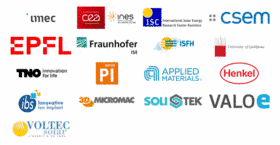Description

At present, the vast majority of PV modules manufactured in the EU are based on imported crystalline silicon (c-Si) solar cells, mostly standard Aluminium Back Surface Field (Al-BSF) technology or Passivated Emitter and Rear Cell (PERC) technology, and conventional cell interconnection technology (soldering of flat ribbons). This results in PV modules with moderate performance and relatively poor environmental profiles (mostly due to the high CO2 footprint of the imported cells).
The HighLite project aims to substantially improve the competitiveness of the EU PV manufacturing industry by developing knowledge-based manufacturing solutions for high-performance low-cost modules with excellent environmental profiles (low CO2 footprint, enhanced durability, improved recyclability). To achieve this, the HighLite project focuses on thin (down to 100 μm) high-efficiency crystalline silicon solar cells with passivating contacts and capitalizes on the learnings from previous large funded projects. In HighLite, a unique consortium of experienced industrial actors and leading institutes will work collectively to develop, optimize, and bring to high technology readiness levels (TRL 6-7) innovative solutions at both cell and module levels. In practice, HighLite will demonstrate high-efficiency ¼ size (or smaller) cut solar cells (silicon heterojunction cells with efficiency η ≥ 23.3%, interdigitated back-contact cells with η ≥ 24.3%; only 0.2% less than full size cells) in pilot-line manufacturing. Industrial tools will be developed in the project for assembling these cut-cells into high-efficiency modules tailored for various distributed generation (DG) applications. More specifically, the following developments will take place:
- building-applied PV modules with η ≥ 22% and a carbon footprint ≤ 250 kg-eq.CO2/kWp,
- building-integrated PV modules with η ≥ 21% and improved shading tolerance,
- 3D-curved vehicle-integrated PV modules with η ≥ 20% and a weight ≤ 5 kg/m2.
Finally, HighLite aims to show improved cost and performance (both through indoor testing and outdoor demonstrators) against state-of-the-art commercially available modules. Altogether, it is expected that the solutions developed in HighLite will:
- create more demand in Europe and worldwide for such DG products,
- significantly improve the competitiveness of industrial actors that are part of the consortium, and
- trigger significant investment in the EU PV industry.


